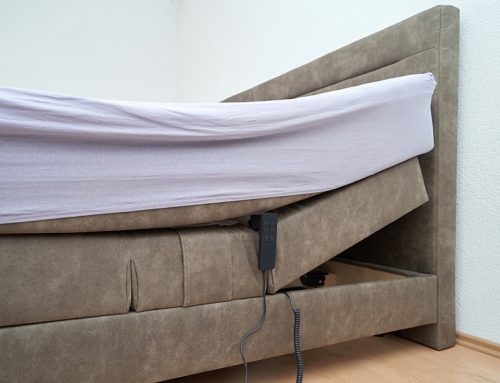5 Tips to Alleviate Pain and Provide Comfort
Sciatica is one of the most common body nerve pains, affecting about 40% of people in their lifetime. And we know what nerve pain entails – restless nights.
Because sciatic pain can either feel like a jolt of lightning to your body or a persistent throbbing soreness, it feels impossible to get the sleep you need. And it differs person to person. For some, sciatica can appear for a few days, for others, it drags on for weeks. Fortunately, if you currently have sciatica, restless nights don’t have to be your fate any longer. Read on for more information about sciatica and how you can go to bed in peace.
How does sciatica pain start?
Good question! Sciatica is a result of a ruptured disc, pinched nerve or slipped disc. Usually from an injury or trauma to the body. Because of this, the foundation of the sciatic nerve is compressed and irritated. And then, as a result, you suffer a tremendous amount of pain and discomfort.
Degenerative disc disease
Pregnancy
Muscle spasms
Osteoarthritis
Sleeping on a mattress that is too soft
Obesity
and more
Always consult with your doctor if you think you’re affected by sciatica to understand your personal situation better.
What are the signs and symptoms of sciatica?
Sciatica is a symptom of back pain along the sciatic nerve, otherwise known as the lumbar spine. This dominantly runs from your lower back but runs to your hips, buttocks and then down each leg all the way to your feet. That’s a lot of body parts!
More than that – the sciatic nerve includes two of the largest nerves in your body, so you’ll likely experience it anywhere in the lower half. Pain can range from a slight ache to jolting pain around one side of the body more. It might also feel aggravated after sitting, coughing or sneezing. Some people with sciatica also experience numbness and weak leg muscles.
You should not have to compromise pain for restorative sleep. In fact, when your body is experiencing nerve pain, that sleep is even more critical for your recovery. Below are some tips to help you get into a comfortable sleeping state while preventing pain throughout the night.
5 tips for sleeping when you have sciatica
The last thing you want when you have sciatica is throbbing pain as you’re trying to fall asleep. Here are some easy to do, at home approaches to help those with mild to moderate sciatica sleep better.
1. Get a high quality mattress
The road to rejuvenating sleep starts and ends with your sleep surface! Your mattress can be a deal breaker for easing or worsening your sciatica pain. Investing in a good quality medium firm mattress cannot be overstated. Scientific based research has demonstrated that a medium firm memory foam mattress that is self-adjusted is the best option for comfort, sleep quality and spinal alignment.
The key with alleviating sciatic pressure is to support your spine, and a firmer mattress is better suited for this purpose.
2. Use pillows effectively
Pillows are a great tool when sleeping with sciatica nerve pain. Here are the best ways to utilize pillows:
- If you sleep on your side, then place a body pillow in between your knees to keep your spine aligned;
- If you sleep on your back or just when resting on your back, place a pillow under your knees to relieve pressure off your back;
- Keeping your spine aligned also means supporting your neck properly. Replace your soft, cushy pillow with a high-quality neck pillow to straighten your upper body and spine.

3. Enact a bedtime ritual
This is one of the essential approaches to falling asleep better and faster, but what should you prioritize in this instance? Setting time before you go to sleep to take a bath and perform some light stretches will be extremely beneficial.
Having a bath will not only soothe your mind, it will soothe your muscles around the sciatic nerve root of your spine. Run the bathwater warm, soak and feel the effects of endorphins kicking in and pain kicking out.
Adding some light stretching into your bedtime routine will also help reduce and prevent lower back tension as you’re trying to sleep. These four yoga poses are ideal to incorporate into your nighttime ritual to help treat sciatica pain.
4. Choose the right sleeping position
When it comes to choosing the best sleeping position with sciatica, anything but the stomach is a good position. Stomach sleeping will not be in your best interests here because it will flatten your spine and twist your neck. It can also lead to more long-term back and spinal problems. Aim for sleeping on your side or back to relieve sciatica pain.
5. Pain-relief solutions
A few at-home, pain relief remedies include:
- Taking prescribed medications from your doctor before going to bed. Otherwise, over-the-counter anti-inflammatory medications like ibuprofen or acetaminophen will bring down the pain.
- It’s not as therapeutic as going to the spa, but conducting some simple massages on your own can bring down inflammatory, sciatic symptoms. Use your palm to gently rub the small of your lower back in downward motions. Or lie flat on your back with your knees bent and place both hands into knuckled fists under your lower back on both sides.
- Use heat or ice packs on your tailbone, lower back or buttocks for 20 minutes before you fall asleep.
If it gets worse or you’re still in pain…
Talk to a healthcare professional immediately. Chiropractors are also great resources. Our tips are meant to be short-term methods to help combat sciatic pain and get comfortable for bed. They help lessen the nerve symptoms enough to slip into a restful state but chronic, long-term pain should be addressed.





